Tianfu Qi
Baseband Model, Cutoff Rate Bounds and Constellation Shaping for Mixed Gaussian-Impulsive Noise
Sep 03, 2025Abstract:Mixed noise, composed of white Gaussian noise (WGN) and impulsive noise (IN), appears in numerous communication scenarios and can severely degrade system performance. In this paper, we address this issue by optimizing the transmitted constellation under mixed noise based on a theoretical analysis of the cutoff rate (CR). First, starting from the passband model of the mixed noise, we derive its corresponding baseband representation. Due to the complexity of the CR, an exact analytic expression is generally intractable. Therefore, the baseband noise model is employed to obtain closed-form lower and upper bounds of the CR. A piecewise linear approximation is applied to derive efficient bounds by exploiting the algebraic properties of the integral terms. These bounds are then used as criteria to optimize the transmitted constellation points in both geometric and probabilistic distributions. The projected gradient method is employed to solve the optimization problem, and the convergence and properties of the solutions are analyzed. Numerical results demonstrate that the proposed CR bounds are tight and exhibit the expected asymptotic behavior. Furthermore, the optimized constellation scheme achieves a significant rate improvement compared to baselines.
Polarization under the Channel Noise with Memory
Nov 25, 2024Abstract:The channel polarization under the channel noise with memory is comprehensively studied. With the help of the genie-aided channel, we prove that the polarized channels also converge to extremal channels under the standard polar codes structure. More importantly, the ratio of the perfect channel can be larger than $I(W)$ which is the capacity of the original channel. However, the polarization rate is shown to be slower than the binary-input discrete memoryless channel (DMC) case. Specifically, the upper bound of the block error is $\mathcal{O}(L^{-c_0})$ where $L$ is the block length and $c_0$ is some positive constant. Furthermore, the upper and lower bound of the gap between the capacity and cutoff rate is investigated when the block length is finite, which is more useful for practical applications.
Communications under Bursty Mixed Gaussian-impulsive Noise: Demodulation and Performance Analysis
May 09, 2024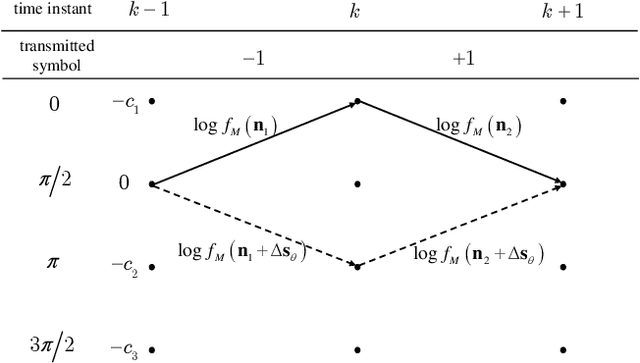

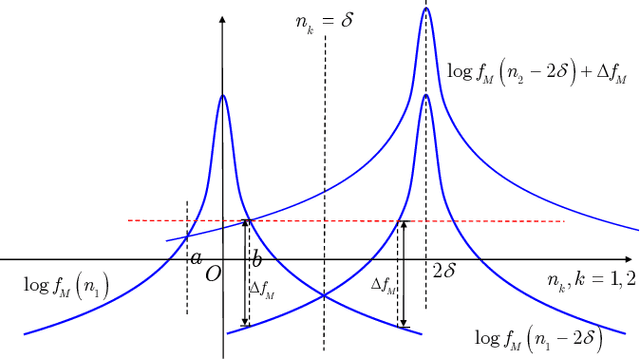
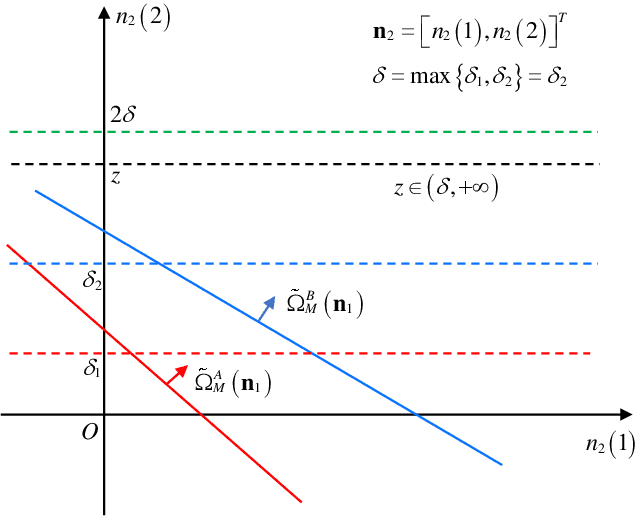
Abstract:This is the second part of the two-part paper considering the communications under the bursty mixed noise composed of white Gaussian noise and colored non-Gaussian impulsive noise. In the first part, based on Gaussian distribution and student distribution, we proposed a multivariate bursty mixed noise model and designed model parameter estimation algorithms. However, the performance of a communication system will significantly deteriorate under the bursty mixed noise if a conventional signal detection algorithm with respect to Gaussian noise is applied. To address this issue, in the second part, we leverage the probability density function (PDF) to derive the maximum likelihood (ML) demodulation methods for both linear and nonlinear modulations, including M-array PSK (M-PSK) and MSK modulation schemes. We analyze the theoretical bit error rate (BER) performance of M-PSK and present close-form BER expressions. For the MSK demodulation based on the Viterbi algorithm, we derive a lower and upper bound of BER. Simulation results showcase that the proposed demodulation methods outperform baselines by more than 2.5dB when the BER performance reaches the order of magnitude of $10^{-3}$, and the theoretical analysis matches the simulated results well.
A Statistical Model of Bursty Mixed Gaussian-impulsive Noise: Model and Parameter Estimation
Feb 09, 2024Abstract:Non-Gaussian impulsive noise (IN) with memory exists in many practical applications. When it is mixed with white Gaussian noise (WGN), the resultant mixed noise will be bursty. The performance of communication systems will degrade significantly under bursty mixed noise if the bursty characteristic is ignored. A proper model for the bursty mixed noise and corresponding algorithms needs to be designed to obtain desirable performance but there is no such model reported to the best of our knowledge. The important problem is addressed in the two-part paper. In the first part, we propose a closed-form heavy-tailed multivariate probability density function (PDF) that to model the bursty mixed noise. This model is the weighted addition of gaussian distribution and student distribution. Then, we present the parameter estimation method based on the empirical characteristic function of the proposed model and analyze the performance of the parameter estimation. Numerical results show that our proposed bursty mixed noise model matches the measured bursty noise well. Meanwhile, the parameters of the proposed noise model can be accurately estimated in terms of mean square error (MSE).
Channel Capacity and Bounds In Mixed Gaussian-Impulsive Noise
Nov 15, 2023



Abstract:Communication systems suffer from the mixed noise consisting of both non-Gaussian impulsive noise (IN) and white Gaussian noise (WGN) in many practical applications. However, there is little literature about the channel capacity under mixed noise. In this paper, we prove the existence of the capacity under p-th moment constraint and show that there are only finite mass points in the capacity-achieving distribution. Moreover, we provide lower and upper capacity bounds with closed forms. It is shown that the lower bounds can degenerate to the well-known Shannon formula under special scenarios. In addition, the capacity for specific modulations and the corresponding lower bounds are discussed. Numerical results reveal that the capacity decreases when the impulsiveness of the mixed noise becomes dominant and the obtained capacity bounds are shown to be very tight.
Communication under Mixed Gaussian-Impulsive Channel: An End-to-End Framework
Jan 19, 2023



Abstract:In many communication scenarios, the communication signals simultaneously suffer from white Gaussian noise (WGN) and non-Gaussian impulsive noise (IN), i.e., mixed Gaussian-impulsive noise (MGIN). Under MGIN channel, classical communication signal schemes and corresponding detection methods usually can not achieve desirable performance as they are optimized with respect to WGN. Moreover, as the widely adopted IN model has no analytical and general closed-form expression of probability density function (PDF), it is extremely hard to obtain optimal communication signal and corresponding detection schemes based on classical stochastic signal processing theory. To circumvent these difficulties, we propose a data-driven end-to-end framework to address the communication signal design and detection under MGIN channel in this paper. In this proposed framework, a channel noise simulator (CNS) is elaborately designed based on an improved generative adversarial net (GAN) to simulate the MGIN without requirement of any analytical PDF. Meanwhile, a multi-level wavelet convolutional neural network (MWCNN) based preprocessing network is used to mitigate the negative effect of outliers due to the IN. Compared with conventional approaches and existing end-to-end systems, extensive simulation results verify that our proposed novel end-to-end communication system can achieve better performance in terms of bit-error rate (BER) under MGIN environments.
Parameter Estimation of Mixed Gaussian-Impulsive Noise: An U-net++ Based Method
Sep 06, 2022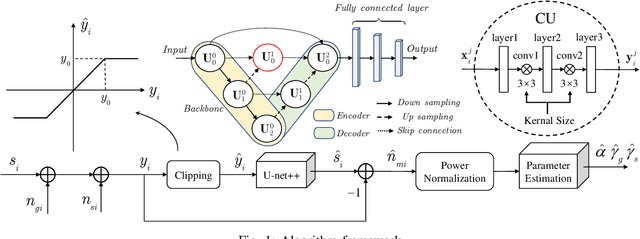
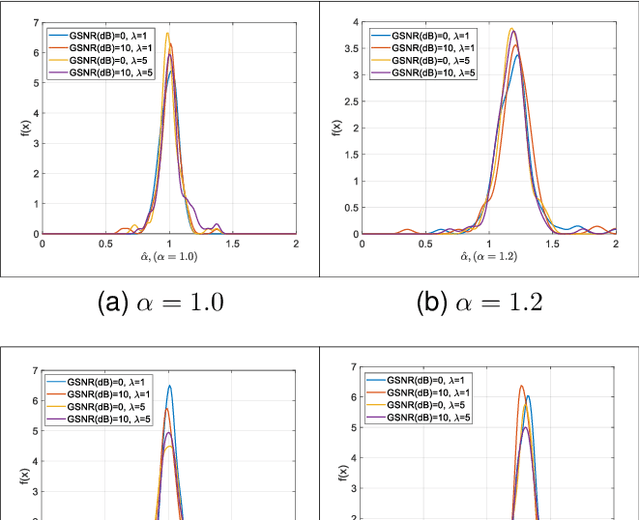
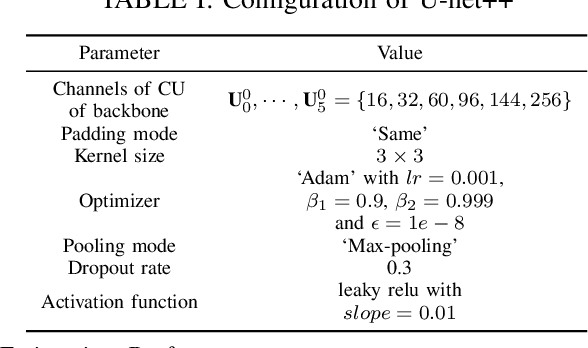
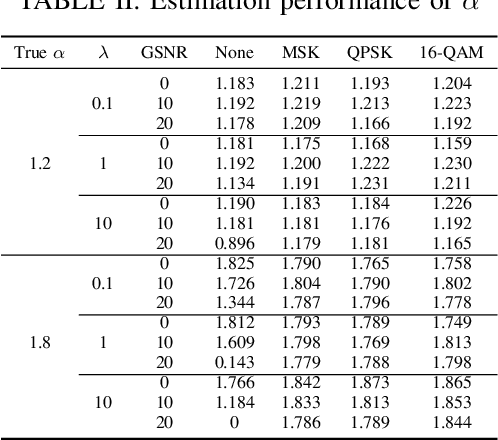
Abstract:In many scenarios, the communication system suffers from both Gaussian white noise and non-Gaussian impulsive noise. In order to design optimal signal detection method, it is necessary to estimate the parameters of mixed Gaussian-impulsive noise. Even though this issue can be well tackled with respect to pure mixed noise, it is quite challenging based on the received single-channel signal including both transmitting signal and mixed noise. To mitigate the negative impact of transmitting signal, we propose a parameter estimation method by utilizing a neural network, namely U-net++, to separate the mixed noise from the received single-channel signal. Compared with existing blind source separation based methods, simulation results show that our proposed method can obtain rather better performance in terms of estimation accuracy and robustness under various scenarios.
Knowledge Graph Based Waveform Recommendation: A New Communication Waveform Design Paradigm
Jan 24, 2022



Abstract:Traditionally, a communication waveform is designed by experts based on communication theory and their experiences on a case-by-case basis, which is usually laborious and time-consuming. In this paper, we investigate the waveform design from a novel perspective and propose a new waveform design paradigm with the knowledge graph (KG)-based intelligent recommendation system. The proposed paradigm aims to improve the design efficiency by structural characterization and representations of existing waveforms and intelligently utilizing the knowledge learned from them. To achieve this goal, we first build a communication waveform knowledge graph (CWKG) with a first-order neighbor node, for which both structured semantic knowledge and numerical parameters of a waveform are integrated by representation learning. Based on the developed CWKG, we further propose an intelligent communication waveform recommendation system (CWRS) to generate waveform candidates. In the CWRS, an improved involution1D operator, which is channel-agnostic and space-specific, is introduced according to the characteristics of KG-based waveform representation for feature extraction, and the multi-head self-attention is adopted to weigh the influence of various components for feature fusion. Meanwhile, multilayer perceptron-based collaborative filtering is used to evaluate the matching degree between the requirement and the waveform candidate. Simulation results show that the proposed CWKG-based CWRS can automatically recommend waveform candidates with high reliability.
 Add to Chrome
Add to Chrome Add to Firefox
Add to Firefox Add to Edge
Add to Edge